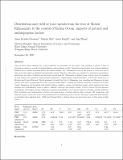| dc.description.abstract | Cases of water related diseases due to metal pollution are increasing over the global. The condition is serious to most of developing countries as a results of industrialization and population growth. Dissolved and particulate trace elements influence drinking water, aquatic ecosystem health and climate change. Mt. Kilimanjaro is one of the sources of water and icon in Africa but miss studies on dissolved and particulate metals. Therefore, this study was conducted to investigate geochemistry, distribution and yield of dissolved and particulate metals from Mt. Kilimanjaro to Indian Ocean. Surface water was sampled in rainy season and analyzed by high resolution inductively coupled plasma mass spectrometry in State Key Laboratory of Estuaries and Coastal Research. Health assessment revealed that level of Aluminium, iron, vanadium and Manganese in some stations were above recommended level, that can pose health impact to human and aquatic ecosystem. Correlation of Cobalt, Copper, Manganese and Vanadium with dissolved silicate, sulphate, calcium and dissolved organic carbon indicates that these elements were predominantly found in silicate, sulphide, carbonate and organic bounds. Positive relation between magnetic susceptibility with Copper and zinc reflects that magnetic susceptibility can be used as indicator of Copper and Zinc pollution. Rock weathering and anthropogenic activities were main sources of metals whereas redox reactions, pH, temperature and dissolved organic carbon were some of biogeochemical factors influencing level of metals. The basin transported more elements in particulate than dissolved form. Yield from Pangani River to Indian Ocean was lower than most of other rivers in East Africa. | en_US |

